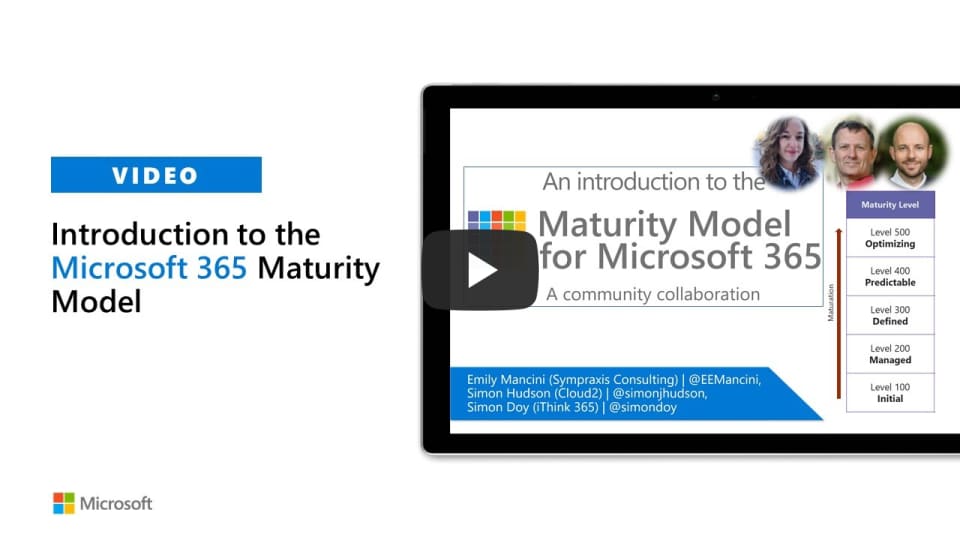Maturity Model for Microsoft 365 - Introduction
Note
This is an open-source article with the community providing support for it. For official Microsoft content, see Microsoft 365 documentation.

Purpose
We often hear from people in the community that they know they aren't using Microsoft 365 capabilities as fully or as efficiently as they would like. Sometimes this can be an existential dread rather than a specific set of clear ideas about what is missing or what to do to work smarter.
Taking a holistic view of the technology through the lens of the Maturity Model for Microsoft 365 and gaining an understanding of current state vs. desired state can help organizations in these important ways:
- Understand and compare options for solving business problems
- Focus time, energy, and resources on the right priorities
- Identify the budget and resources needed to move ahead
- Establish a baseline to show improvement over time
Maturity Model for Microsoft 365 summary
The Microsoft 365 platform is vast and changes rapidly, but business needs are common and slower. The Maturity Model for Microsoft 365 concentrates on defining a set of business competencies, that resonate with Microsoft 365 yet underpin real business activities. Together, the documents create a set of tools, not just information. These should allow organizations to figure out where they are in any function or department and what ‘better’ entails. Not only should the Maturity Model for Microsoft 365 not be about features, but it shouldn't be just about IT either; so we it uses common language that all sorts of business roles can understand so that everyone can use the model.
In developing a maturity model for Microsoft 365 we aimed to create a toolkit which follows a set of principles:
- Non-partisan, i.e. informed by but not driven by today’s features in any specific platform
- Led by business needs rather than technology features
- Identifies key business *and- technical competencies
- Enables organizations to evaluate the current state in a systematic and consistent way
- Applicable to various roles in the organization
Competencies
Published
- Business Process
- Collaboration
- Communication
- Customization & Development
- Employee Experience
- Governance, Risk, and Compliance
- Infrastructure
- Management of Content
- People & Communities
- Search
- Staff & Training
In progress
- Data & Analytics
Maturity Levels
The 5 levels within the Maturity Model for Microsoft 365 can be summarized as:
Level 100 - Initial
- Default, starting/exploratory state
- People driven processes, lacking documentation and discipline
- Many ways of doing the same thing (with variable results)
- Characterized by inefficient legacy approaches and pockets of un-managed innovation
Level 100 - Keywords
Ad hoc, reactive, uncontrolled, chaotic, unstable
Level 200 - Managed
- Key processes defined but not standardized, uniformly or strongly applied
- Some ability to demonstrate consistent outcomes
- Limited buy-in from staff and management
- Widespread inconsistency and resistance
Level 200 - Keywords
Routine, legacy, firefighting, variable, personally managed
Level 300 - Defined
- Defined and standardized
- Signed off, managed process
- Limited validation of effectiveness, doesn’t include edge cases
- Process users demonstrate familiarity
Level 300 - Keywords
Documented, policy-driven, planned, controlled, stable
Level 400 - Predictable
- Actively managed in accordance with agreed processes and has tracked metrics
- Effective achievement can be evidenced across a range of operational conditions
- Process has been tested and refined
- Process users demonstrate competence
Level 400 - Keywords
Productive, interactive, responsive, enhanced, effective, adaptable, quality
Level 500 - Optimizing
- Deliberate and systematic process improvement/optimization
- Focus is on continually improving process performance
- Management of the processes are concerned with addressing statistical common causes of process variation and changing the process to improve process performance
Level 500 - Keywords
Optimal, systematic, statistical, improvement-focus, automated, assured, proactive
What's next?
The goal of expanding the SharePoint Maturity Model (SPMM) to the Microsoft 365 level is to help practitioners in the community think through how they can improve their capabilities or decide which capabilities matter most to them. These decisions should be based not just on the technology capabilities themselves, but driven by specific outcome objectives derived from the organizational strategy, possibly at a reasonably granular level as well as at the over-arching organization level.
Our goal is to apply the same core competencies that were the core of the original SharePoint Maturity Model, updated and extended to reflect the current business and technical environment. As Microsoft 365 is a much deeper and wider toolkit, the project is creating a guidance document for each competency, in a consistent format. Although these are clearly linked to Microsoft 365, we have deliberately avoided detailing particular features and functions, focusing on the business needs and processes in the competency documents. We will continue to expand the document set to drill into the technologies; provide a ‘how to’ for achieving different levels with the tools Microsoft 365 provides; and highlight some practical scenarios.
Resources
Origin of the Maturity Model for Microsoft 365
Tip
Join the Maturity Model Practitioners: Each month we host sessions exploring the value and use of the Microsoft 365 Maturity Model and how you can successfully develop your organization using Microsoft 365. Each of these sessions focuses on building a community of practitioners in a safe space to hone your pitch, test your thoughts, or decide how to promote your use of the Maturity Model. Sessions include a presentation on a topic about the Maturity Model, including recent updates. Calendar link
Principal authors:
The MM4M365 core team has evolved over time and these are the people who have been a part of it.
Core team
- Marc D Anderson, MVP
- Simon Hudson, MVP
- Simon Doy, MVP
- Sharon Weaver
- Galen Keene
- Pia Langenkrans
- Mats Warnolf
Emeritus
Microsoft 365 community content
